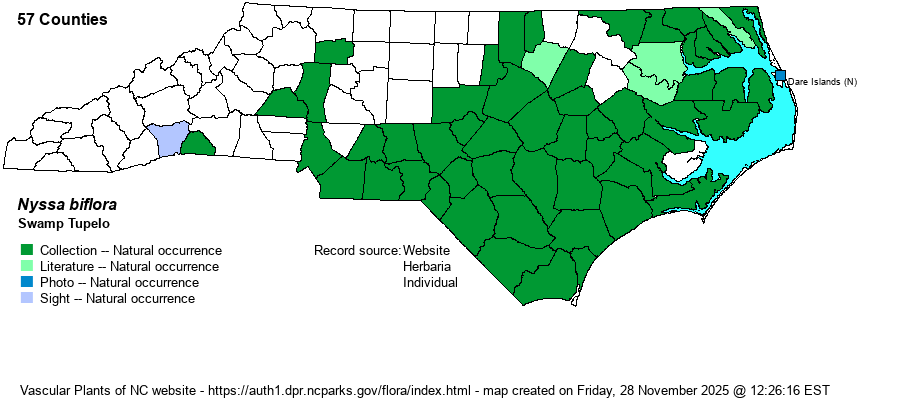| Author | Walter | |
| Distribution | Throughout the Coastal Plain, and ranging into the extreme eastern edge of the Piedmont, as far west as Granville, Chatham, and Union counties; slightly disjunct farther west to several western counties (at least to Yadkin and Henderson counties).
This is a Southern species mostly found in the Coastal Plain, but ranging into the Piedmont and foothills. Occurs from NJ southwest to TN and AR, and south to the Gulf Coast.
| |
| Abundance | Common and much more widespread in the Coastal Plain than is Water Tupelo (N. aquatica); one of the more frequently seen trees in swamps and other forested wetlands. Uncommon in the extreme eastern Piedmont, very rare and local in the central Piedmont. | |
| Habitat | Though the species is not normally found along brownwater river floodplains, it is practically ubiquitous in blackwater floodplains, small stream swamps and bottomlands, wetter pocosins and bays, ponds and pools, and many other wet places in peaty soil. |
| Phenology | Flowers from April to June, and fruits from August to October. | |
| Identification | Though the species has often been considered a part of the mainly upland Blackgum (N. sylvatica), and it can also be confused with Water Tupelo, this tree is a very familiar one to most biologists, though some care must be taken in identification. It is a medium deciduous tree growing to about 70 feet tall, with a somewhat narrow crown and a somewhat swollen base (though not as swollen as in Water Tupelo). The leaves are alternate, essentially entire, narrowly elliptic to more often oblanceolate, about 4 inches long but seldom more than 1.5 inches wide. They are shiny above and a bit thick, with a somewhat rounded tip. Usually you can find a few to many red-colored leaves on the trees even in summer, well before all of the leaves truly turn bright red in fall. The dark purple drupes are conspicuous but are smaller than those of Water Tupelo. Where this species grows in drier floodplains or other non-swamp conditions, you may have some trouble with separation from Blackgum. The leaves of that tree are normally wider and more rounded (more elliptical), and tend to have a sharper leaf tip, often acuminate. Blackgum leaves are not usually shiny above. | |
| Taxonomic Comments | Many references still do not separate this species from N. sylvatica, but most of the Southern-based references do. RAB (1968) and some others had this taxon listed as N. sylvatica var. biflora. It seems as though scientists who are intimately familiar with the genus, in the South, are more likely to treat this as a valid species.
| |
| Other Common Name(s) | Swamp Black Gum (or Swamp Blackgum) | |
| State Rank | S5 | |
| Global Rank | G5 | |
| State Status | | |
| US Status | | |
| USACE-agcp | OBL link |
| USACE-emp | FACW link |

